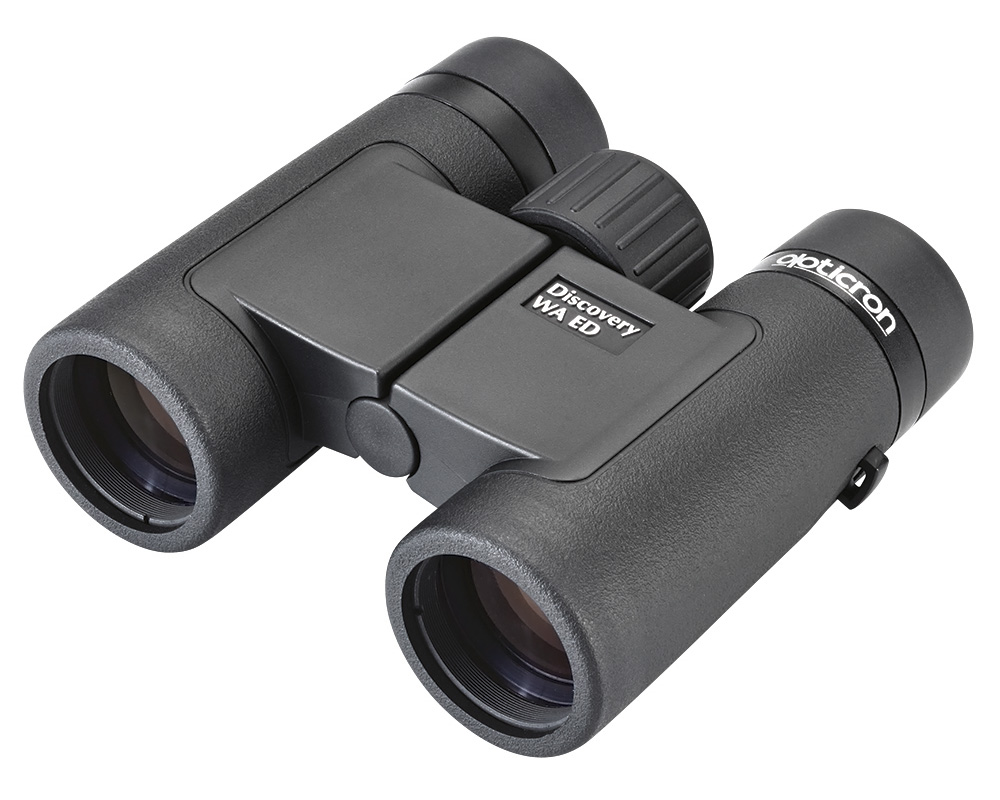Opticron Discovery WA ED 8x32 Binocular
It's been on the market since 2008 and it's still going strong: we're talking about the 8x32 mm offering from Opticron's Discovery range of binoculars, most specifically the WP PC, which has now given birth to an upgrade, the WA ED, offering buyers a wider choice within the range.
Having this recently released model to compare with the established and ongoing WP PC enabled me to examine the differences and assess the enhancements, and to ask that all-important question: is it worth the extra cost?
In terms of weight and dimensions the differences are negligible as both are nicely compact and come in at some 390 g. This is an excellent weight class, adding comfort to both use and carriage, achieved through being constructed from lightweight polycarbonate and aluminium alloy.
While both have a full covering of rubber body armour, the newer model offers a more noticeably dual-textured finish, with extended stippling providing better grip to the barrels and smooth rubber restricted only to the bridge.
The soft rubber-shrouded eyecups of both models are the same, including the usual twist-out mechanics which enable them to be moved to a midway 'soft-locking' position between the base setting and being fully extended. Because the lens on the newer model is slightly more deeply recessed than that of the WP PC, the eye relief on the WA ED is 18 mm, as opposed to 17 mm. On both models, to my eyes, I found the field of view to be very fractionally reduced when the eyecups were fully extended.
The dioptre is located on the right eyepiece in both models. Both offer ample turning resistance in order to preserve their settings but the broad ribbing on that of the WP PC provides better grip and is therefore easier to operate.
There is no such difference in the construction of the central focusing wheels – they are identical, widely ribbed and operate in the same manner with approximately 1.75 anticlockwise turns taking the image from close focus to infinity on the ED, with very fractionally more turning on the original model. Focusing is otherwise fast with just under a quarter of a turn required to focus between 10 m and long distance in the ED and slightly less in the older model.
I have to say there is an odd combination of letters depicted on the focusing wheels of both models. The 'WP PC ED' on the WA ED conflicts with the new model name and is part of the old model name, while 'DWCF GA' sits atop the wheel on the WP PC, which buyers might find puzzling. I must admit I do.
Opticron's figure for close focus is 1.2 m for both models, although I couldn't get below 1.3 m, but I won't quibble as this is an admirable value for any binocular.
When it boils down to it, though, the principal reason for the introduction of an upgraded version of the Discovery is to improve the quality of the image it delivers.

In a side-by-side comparison, the first and most obvious difference is the higher level of brightness of the WA ED. This feature results from improvements to the optical system and the use of Opticron's Oasis-C+ high light transmission prism coatings.
There is also a much-improved portrayal of image colour, which is also clearly obvious. In this respect, the WA ED delivers a more natural-looking image, aided by the enhanced brightness and lacking the warmer and slightly yellowish overtones found in the WP PC. This is most obvious when a single field of view combines an array of different colours provided by sky, water and vegetation comprising many different hues.
The improved field of view offered by the WA ED – 140 m at 1,000 m – is another feature obvious in direct comparison with the 131 m of the WP PC and to my eyes it was sharp almost to the edge in the upgraded model, but a little softer further in on the WP PC.
Another important feature of the WA ED is the noticeably lower level of chromatic aberration in comparison to that of that of the WP PC, no doubt resulting from the introduction of extra-low dispersion glass in the objectives. A commendable boon to users.
To complement this binocular is a soft carry case, an articulated rainguard – which provides maximum flexibility and slips on and off the eyecups without changing their positioning – a neoprene lanyard and rubber objective lens covers.
In summary, I have to say this neat little binocular is an all-round winner, particularly when price is taken into consideration. Given the list price of the older WP PC is £179 and its current 'street' price can be as low as £149, paying anything between £20 and £50 more for the new WA ED is well justified, in my opinion.
Further info
- Price: £199
- Size: 108 x 117 mm
- Weight: 390 g
- Field of view: 140 m at 1,000 m
- Light transmission: not available
- Close focus: 1.2 m
- Gas-filled: yes
- Waterproof: yes
- Guarantee: 5 years
Verdict
+ Lightweight and well-designed
+ Optically very impressive for the price
- Confusing labelling on model


